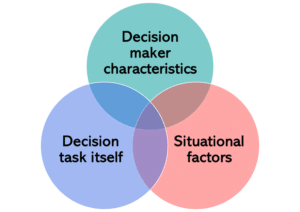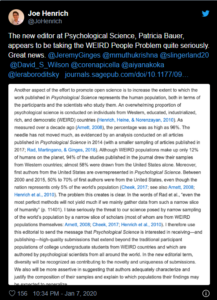By Elina Halonen
Over the past 10 years, applied behavioural science grown more and more popular in across a range of industries and sectors. As it spreads across the globe, we are at a point where we need to consider whether we are as “irrational” as we seem and, more importantly, whether we are all “irrational” in the same way – in other words, does behavioural science as we know it travel well?
In this series of blog posts I shed light on the ways in which factors such as cultural context influence individual decision making (beyond just social norms), and the ways in which what we know about the human mind is often based on a limited sample of humanity.
Why We Need to Consider the Cultural Context of Decision Making
Although much of the literature particularly on behavioural economics has focused on the influence of context, it often merely focuses on the immediate decision-making moment. In addition to the bounded nature of our minds, there are actually three sets of factors that affect every choice and decision: decision features, situational factors and individual differences.

Features of the decision task include factors such as whether the decision maker has been primed in a certain way and how the options are framed or ordered.
In addition to the decision, every decision is also affected by situational factors: for example, the cognitive load, time pressure or social context experienced when making the decision.
Finally, every decision is also influenced by characteristics of decision maker: their age, gender, personality traits, social class as well as the cultural context they grew up in. This blog series will touch on all of these, but mainly focus on the impact of cultural context.
The first two, decision features and situational factors, have received a lot of attention among scientists, which is reflected in the popular science portrayal of behavioural economics (e.g. Nudge and Predictably Irrational) and consequently they have also featured prominently in the public discussion around behavioural economics whereas the impact of individual factors such as culture has been largely ignored.
The mental shortcuts we take are connected to underlying psychological processes which are affected by the cultural context we have grown up in. Culture affects decision making in many ways so it is fundamentally important to understand how behavioural phenomena such as endowment effect might work differently in different cultures because this will consequently affect how we apply the ideas from behavioural science into practice.
Psychology Is Extremely WEIRD
Unfortunately, most of the academic research on decision making has been conducted almost exclusively in Western countries and especially in the US: 96% of samples in psychological studies come from countries with only 12% of the world’s population (Western industrialised countries, specifically North America, Europe, Australia and Israel). Although things are slowly changing, two thirds of this 12% comes from the US, which means that a randomly selected American is 300 times more likely to be a research participant than is a randomly selected person from outside of the West.
This should be a shocking statistic to anyone: if you replace “American” with any other nationality (e.g. Brazilian, Chinese, Nigerian), and imagine the majority of what we know about human psychology is based on that, you would probably feel it undermines the entire discipline because you would consider if culturally specific. In fact, this already happens: some journals consider research done on non-US populations as eccentric and culturally specific, yet research done with US samples is usually framed as being descriptive of humans in general. (Oh, and of course most of the research has also been done with people of white/Caucasian background.)
The majority of psychological research originates in countries that are commonly referred to as WEIRD (Western, Industrialised, Educated, Rich and Democratic), which makes them vastly unrepresentative as a sample in psychological research. Using findings from research based on a narrow slice of humanity suggests that we are implicitly assuming that cognitive biases (among other things) are universal and function largely in similar ways in different cultures.
Except evidence suggests otherwise.
A recent review of experimental findings in a range of cultures found substantial variability in results in some of the most basic psychological domains: visual perception, fairness, spatial reasoning, moral reasoning, thinking styles and self-concepts. Moreover, their findings suggest that standard subjects in psychological studies are actually an outlier compared to the rest of the human species, and that to truly understand humanity, we need to sample a broader selection of cultures.
Going even further, most of behavioural science research is conducted by people from a certain type of background:
Psychology may be the least international of all the social sciences and it certainly is more parochial than any of the natural sciences. Therefore, there is plenty of reason to think that a different point of origin would have led to a different current state of the art. — To what extent do our current understandings of our field depend on the gender, ethnicity, SES, political leanings and cultural identification of the scientists who are conducting psychological research?
Cross-Cultural Research Helps Unpack Foundations of Behaviour
While cross-cultural research into decision making is still limited, the emerging evidence suggests that applied behavioural science as a field will hugely benefit from it – partly because observed differences can help unpack the deeper foundations of behaviour.
If a psychological phenomenon such as the endowment effect works differently or to a lesser degree in another cultural context, researchers can start to ask why that might be – and consequently discover the boundary conditions that govern that particular effect.
Given the emphasis of many cognitive decision-making theories on the impact of immediate context such as framing or priming, it should be surprising how little the broader cultural context is taken into account. While social psychology has a wealth of knowledge on how cultural context affects us, theories in cognitive psychology rarely consider culture as a factor due to implicit assumptions about the universality of cognitive processes: in other words, what we think about may vary, but how we think is always the same.
Even Colour Is in the Eye of the Beholder’s Culture
Even fundamental cognitive functions such as how we perceive colour or simple optical illusions can significantly differ based on the cultural context you’ve grown up in.

While it might seem reasonable to assume that people all over the world perceive something as basic as colour similarly, researchers have found that colour categorisation can vary considerably depending on language: in other words, actual cognitive categories for colour are tightly tied to the linguistic terms used to describe them. For example, members of the Himba tribe cannot distinguish between green and blue, whereas other research has shown that Russian speakers’ compulsory differentiation between lighter and darker blue enables them to identify and categorise colours faster compared to English speakers.
While it may seem more likely that colour categorisation should be linked to colour, many people would suspect that tasks requiring even more basic cognitive processes would not vary across different populations around the world. However, perception of seemingly simple optical illusions have been shown to vary across cultures and even age groups. The Müller-Lyer arrows is an optical illusion where the line in the top arrow appears longer than the bottom one, despite both being the same length.
However, research has showed that the illusion is strongest for American undergraduates and almost entirely disappears for those from the San forager tribe in the Kalahari desert – for them, it is not an illusion at all as they are able to see the two lines as being equal length. In addition, the results of the American undergraduates are significantly different from all the other 15 societies surveyed.

If even a cognitive process as simple as visual perception can vary significantly across different cultural contexts, what does that suggest for more complex psychological processes? While we do not know for certain if and how they vary, without scientific research we cannot assume that they operate similarly. Furthermore, American undergraduates, on whom large swathes of psychological theory is based, are potentially at the extreme end of the distribution and therefore significantly different from other populations. Finally, studies like these show how cross-cultural research can help illuminate the underlying psychological processes and give us a deeper understanding of those phenomena.
Culture Is One of the Biggest Challenges for Behavioural Science as a Field
Despite the evidence of this variation among populations in psychology, there is still limited research into cross-cultural differences and the impact of cultural context in judgment and decision-making psychology. As Dan Ariely puts it:
The biggest challenge for our field in the next 10 years would be to understand the generality of the findings we have. We have lots of findings and different aspects and we have assumed for a long time that they would just carry over in different contexts and different occasions.
Of course, when we talk about the theory of mind or psychology, the context doesn’t have to be part of the theory, but as we get access to more people and more cultures, I think we’ll have to have a more nuanced understanding of our theories and we will have to learn to adjust them based on other intervening factors that might come from culture for example.
We have been ignoring culture too much. It has less to do with the theory and more to do with application: as we try to apply things and try to change human behavior, we will need to understand those nuances to a larger degree.
Other researchers, like world-renowned social psychologist Hazel Markus from Stanford University went even further in a conference keynote in 2014 and suggested that “every behavioural economics effect we know is WEIRD”.

Thankfully, things are changing and there is an emerging trend to allocate more attention to understanding the nuances of the findings we have so far has been emerging at the conferences and in journals of this field in the past couple of years. For example, the new editor of Psychological Science has made it a priority to expand the slice of humanity we are studying.
We know that economic, social and linguistic environments strongly shape people’s behaviour, motivations and preferences, so why has culture received so little attention in judgment and decision making psychology?
In the next episode of this blog series, I will explore this question in more detail.


